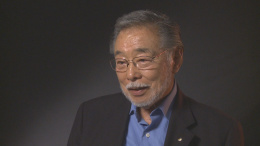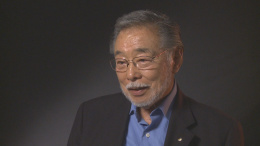Santa Anita riot
A disturbance at Santa Anita Assembly Center on August 4, 1942, represented building tensions over increasing administrative policies restricting use of Japanese language for meetings, in printed materials, and even in music. In addition, complaints had been growing over the poor quality of education for children, and over a general distrust of internal security police. The so-called "riot" was sparked on August 4th by a surprise inspection of all barracks, and by rumors that in addition to the removal of hotplates, dishes, books, and record albums, internal security were also taking money and jewelry. In response, some Nisei attacked a number of Internal Security Police and threatened others. After the incident, eleven young men were sent to Tule Lake (two of whom were under the age of 20) despite vigorous protests from family members who complained that the transfer divided families without adequate justification for the transfers or any assurances of family reunification. The riot also resulted in a change in leadership of the Internal Security Police and an intensified campaign in the Santa Anita newspaper, the Pacemaker to explain administration policies and to quell the spread of rumors.
At the end of May, camp administrators cracked down on all center meetings by banning discussions of anything that could be deemed political in nature whether it be international, national, state or local politics. Following this was a ban on possessing Japanese-language literature unless it was a hymn book or bible. Two weeks later, on July 28, 1942, a ban on all Japanese records, including voice and instrumental recordings, was implemented. Administrators later clarified that only recordings of a "subversive" nature would be banned. Not surprisingly this series of repressive tactics created widespread resentment against administrators for what appeared to be deliberate efforts to make life more miserable than it already was for the incarcerated population.
On August 4th, people observed internal security entering into housing units and carrying out "hotplates, dishes, records, books, screwdrivers, hammers, sacks of rice, etc." [1] Rumors of jewelry and cash being taken spread rapidly. People "stormed" the administrative offices with complaints of police robbery and mistreatment. People gathered outside barracks to prevent searches and recreation hall workers were released to go home and "protect their belongings." A crowd chased a policeman accused of having money and jewelry and chased him into the Orange Mess Hall. He was rescued by other members of the police force. A suspected informant was cornered and severely beaten. If this is the same man identified in other reports, he was of mixed ancestry and was identified as Japanese Korean. He was only identified by the last name of Kawaguchi. Military Police arrived at 3:15 in the afternoon and quelled the unrest, then proceeded to investigate the accusations of theft. They remained until Friday afternoon. Apparently they were courteous and well-received by inmates. [2]
This was not the first disturbance at Santa Anita, and it was not caused by a single event. On June 17, 1942, 800 individuals participated in a sitdown strike. The "riot" on August 4th was explained as a response to a long list of complaints that had accumulated over the first months of Nikkei incarceration in Santa Anita: uncovering of liquor smuggling plot involving Caucasian mess hall supervisors and cooks, evidence of homes being broken into by internal police without knowledge of the individuals assigned to the barracks, distrust of internal security police, "the deplorable" efforts to provide education for the children, and a general hope for improved treatment and a change in administration.
Although Issei did not take an active role in the violence, reports indicated that they were relieved at the uprising as they had been complaining that the Nisei were "spineless" in opposing their wartime treatment. "They had seen with their own eyes that the Nisei could be aroused, when there is just cause to become aroused." One report quoted one Issei observer: "I misjudged the Nisei. They're all right. I'm glad." [3]
In the aftermath of the incident, the chief of internal security was replaced, and the center newspaper, the Pacemaker warned residents that it was dangerous to spread rumors as they often represented misinformation and only damaged morale. The newspaper cited examples from Tanforan where rumors had led to widespread misinformation about the day and method of transfer to the more permanent War Relocation Authority facilities. Officials continued to crack down on meetings held using Japanese language and on illegal gambling. Reports of competing "gangs" originally from Little Tokyo in Los Angeles had been battling over who would control gambling in Santa Anita. [4]
For More Information
Pacemaker August 5 & 8, and 12, 1942.
Scott Harrison, "Japanese Internment: Santa Anita Assembly Center," Framework: LA Times, April 19, 2012. Available at: http://framework.latimes.com/2012/04/19/japanese-internment-santa-anita-assembly-center/#/0 .
Footnotes
- ↑ American Committee for Protection of Foreign Born, "The Evacuee Speaks: Private Newsletter," August 17th, 1943, pp. 1-2. WRA Field Basic Documentation, Santa Anita, Roll 1.
- ↑ Ibid.; Earl Godwin-Blue, Radio Digest, War Department Bureau of Public Relations, August 24, 1942. WRA Field Basic Documentation, Santa Anita, Roll 1; and "Inspection Disturbance Causes Two-Day Army Control." Pacemaker , August 5 and 8, 1941.
- ↑ American Committee for Protection of Foreign Born, "The Evacuee Speaks," p. 2.
- ↑ Ibid.
Last updated July 17, 2015, 3:22 a.m..

 Media
Media
